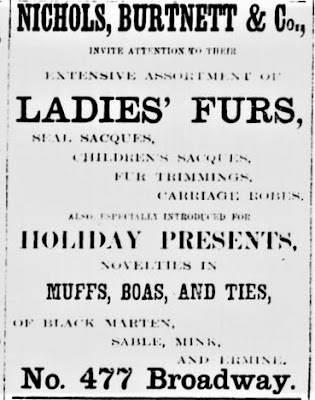477-479 Broadway was once owned by one of New York’s oldest and wealthiest families — the Rhinelanders. At the time that William Christopher Rhinelander and his wife Mary Rogers moved into their carriage house at No. 477 Broadway in 1816, the neighborhood was a predominantly residential one. A few decades later, it transitioned an area overtaken by commerce, and the Rhinelanders moved out of the neighborhood. However, William Rhinelander did not sell No. 477 when they moved, but instead leased it out.
With the onset of the uproar caused by the Civil War, the building (along with the adjacent No. 479) was demolished to be replaced with a modern building with a classical-influenced facade. This five-story cast-iron building was built for them in 1869-70 by H.W. Smith and Sons. The Landmarks Preservation Commission’s SoHo-Cast Iron Historic District designation report states that while the buildings forms are derived from classical sources, its ornamentation was considered “quite fanciful.”
One of the spaces on the ground floor of this newly built building then became home to Nichols, Burtnett & Co., a fancy goods retailer; the top floors were where these goods were manufactured. The other space was also occupied by a fancy goods retailers known as Hugh O’Neill. In 1879, another one of the spaces was taken by another fancy goods merchant — Henry Levy & Son.
Unfortunately, this store was at the center of a con artist’s scheme that same year. A man disguised himself as a newspaper reporter and swindled free items from the store. The New York Herald reported: “Sometimes [Frank] Fox, occasionally [James L.] Jones, more frequently [Morris] Cohen, but under one name or another a strange, eccentric being, has for months been projecting himself into the experience of confiding shopkeepers and credulous officials.” He would walk in and tell Levy that he was Frank Fox from the New York Herald, sent over to do a report on the revival of trade in the country. He promised to broadcast good coverage for the store in return for an interview. He would linger in the store, and would audibly express his liking towards a pocketbook .
Henry Levy & Son departed the building after their business went into bankruptcy. However, it continued to be home to many famed garment manufacturers in the years that came after that. In 1871, Harris and Morris Abrams founded their business in No. 477. However, a year later, lawyers of the businessmen’s creditors accused them of fraud for shipping their goods out of state and preparing for a failure. Harris Abrams then fled town and was later tracked down by a detective in Toronto, where he was arrested.
Then, in 1913, occupied by Stein, Doblin & Co., employees were angered by the hiring of non-union employees. It was then the target of a labor strike turned violent.

Despite being linked to the dramatic stories of many of the businesses housed in its 150 year long history, the cast-iron building still stands, and is remarkably intact, at that!
In 2003, Pearl River Mart occupied the ground floor of the building, where it remained until 2015, when it relocated to TriBeCa. It has since come back to the district and is currently at 452 Broadway. In 2018, Dolby Studio opened a pop-up space offering an interactive and experiential space for its visitors, and earlier this year featured an Immigrants are Essential installation.

Top image: 477 Broadway in 1941. Source: the NYC Dept. of Records & Information Services.